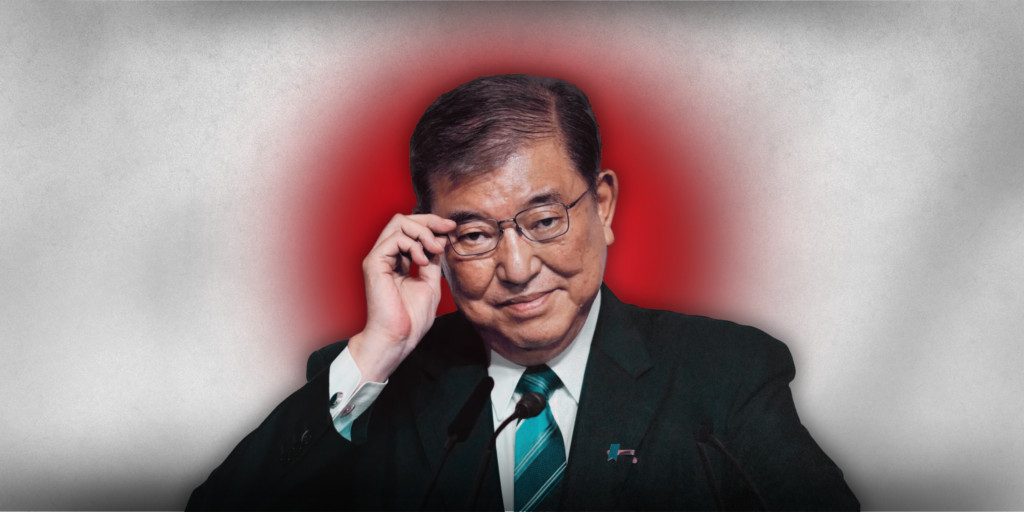Japan’s new Prime Minister, Shigeru Ishiba, a former defense chief and critic of the late Shinzo Abe, is expected to shift Japan’s domestic and international policies towards a more moderate and diplomatic approach, particularly with China, while balancing regional security and strengthening ties with key partners like the US.
Key takeaways
-
Shigeru Ishiba’s election as prime minister marks a shift from Shinzo Abe’s legacy with a more diplomatic approach toward China.
-
Ishiba supports regional security through multilateral cooperation, proposing a NATO-like alliance for Asia.
-
His economic policy emphasizes wealth redistribution and rural revitalization, offering a critique of Abenomics.
In a surprising political turn, Shigeru Ishiba was this month elected as the leader of Japan’s ruling Liberal Democratic Party (LDP), succeeding Kishida Fumio as the country’s prime minister. A former defense minister and a vocal critic of the late Shinzo Abe, a former prime minister, Ishiba’s foreign policy stands in contrast to his predecessors’. While Kishida and Yoshihide Suga closely followed Abe’s legacy, Ishiba represents a new phase in Japanese leadership—one that signals potential shifts in both domestic and international policies, with implications for Europe.
Ishiba’s rise to the LDP presidency has been long and challenging. Despite multiple bids for leadership, he struggled to gain the backing of parliamentary colleagues, even though he enjoyed support from many rank-and-file LDP members. After four unsuccessful runs for party leadership, Ishiba finally secured victory in 2024 on his fifth and, as he called it, “final” attempt.
His success was less about his foreign policy positions and more about shifting dynamics within the LDP, particularly following the dissolution of the powerful Abe faction, the largest in the party, after the former prime minister’s assassination in 2022. In the runoff, Ishiba defeated Takaichi Sanae, a staunch supporter of Abe-era policies, signaling a shift within the LDP from the political right to a more moderate center.
A more diplomatic approach to China
Ishiba advocates for a more diplomatic and engagement-oriented approach toward China, setting himself apart from competitors like Takaichi, who favor a confrontational stance. Although he recently visited Taiwan and recognizes the importance of strengthening Japan’s defense, especially in the East and South China Seas, Ishiba opposes aggressive military buildups solely for power projection. Instead, he promotes “win-win” strategies to reduce tensions and foster cooperation with Beijing.
Ishiba is critical of the dominant “China threat” narrative in Japan, seeing it as an obstacle to constructive dialogue. He values the historical political channels that have helped maintain relations between Japan and China, despite the criticism these efforts often face as being overly accommodating. His pragmatic, balanced stance is a clear departure from the hardline approach of figures like Abe.
Beijing is likely relieved by Ishiba’s election. Had Takaichi been chosen, her hawkish stance toward China would have necessitated substantial diplomatic efforts to ease tensions, especially given the already fragile relations following the recent tragic stabbing of a 10-year-old boy in Shenzhen, an incident reportedly fueled by anti-Japanese sentiment. In response to Ishiba’s leadership, Beijing extended a congratulatory message, emphasizing that as “neighbors separated by a strip of water,” both nations should pursue “peaceful coexistence, friendship for all generations, mutually beneficial cooperation, and common development.”
Ishiba has consistently stressed the importance of regional security, but his vision includes fostering cooperation with China, even amidst existing tensions. He has frequently advocated for diplomatic engagement with Beijing, distinguishing himself from the more hardline factions within his party. Ishiba recognizes the complexities of China-Japan relations, especially in the aftermath of incidents like the Shenzhen stabbing, which has exacerbated bilateral tensions. His foreign policy seeks to strike a balance, ensuring Japan remains prepared for defense while avoiding unnecessary escalation and prioritizing diplomacy over confrontation.
A central element of Ishiba’s foreign policy is his proposal for a NATO-style collective security arrangement in Asia. He envisions an alliance that would include traditional partners like the United States and extend to other Asian nations, aimed at deterring aggression and maintaining peace in the region. However, unlike more hawkish figures, Ishiba’s version of this alliance is not exclusively directed at countering China. Instead, it focuses on fostering multilateral cooperation and regional stability, reflecting a more nuanced approach than the binary “with us or against us” framework often favored by hardliners.
However, this proposal faces substantial challenges. Many Southeast Asian countries, with their intricate economic and political relationships with China, are hesitant to join any military alliance that might be perceived as anti-China, as evidenced by discussions surrounding the opening of a liaison office in Tokyo. Many Southeast Asian countries, for example, would not be in favor of a large-scale security alliance and would much prefer minilaterlism in the region. This lack of consensus on how to address China, coupled with general skepticism about the need for such an alliance, casts doubt on the feasibility of an Asian NATO. Beijing is likely to be strongly opposed to an Asian security alliance. As long as Ishiba is not gaining support for his Asian NATO proposal, China is likely to downplay it and emphasize his pro- China engagement.
In addition to the difficulties in rallying regional support, Ishiba’s broader defense strategy, which includes revisiting the Japan-US Status of Forces Agreement (SOFA) and stationing Japanese Self-Defense Forces (JSDF) in Guam as part of a regional deterrence strategy, has not been warmly received by Washington. While these plans are intended to lessen Japan’s dependence on US forces and increase its role in its own defense, they risk complicating relations with the US. This comes at a time when cooperation between Japan and the US in countering regional threats—particularly from China—has made significant progress and remains crucial for regional stability.
Balancing the US alliance with Japan’s autonomy
Ishiba has consistently pushed for renegotiating Japan’s security alliance with the United States to establish a more “equal” partnership, reflecting his desire for Japan to take a more autonomous role in its own defense. Central to this vision is his interest in revising Japan’s constitution, particularly Article 9, to clarify the role of Japan’s military. This move is seen as part of a larger strategy to increase Japan’s defense capabilities while avoiding unnecessary confrontation with its neighbors.
Despite Ishiba’s defense expertise and credibility as an expert in military affairs, analysts suggest that implementing significant changes to the US-Japan alliance will be challenging. The security agreement, a pillar of Japan’s postwar policy, is deeply entrenched and has provided Japan with a security umbrella while allowing the US a strategic presence in Asia. Restructuring this alliance could prove difficult, especially given the complexities of regional security dynamics.
His proposal to station JSDF forces in Guam, for example, could shift some of the defense burden away from US forces in Japan, but it also risks complicating the delicate balance of power in the region, particularly as China continues to assert its influence. Ishiba’s ideas for a more independent Japan dovetail with his broader vision of engagement with China, where Japan is shifting away from being overly reliant on the US and can maintain less antagonistic relations with Beijing. While China is likely to react sensitively to Japan’s military strengthening, this development should hardly come as a surprise, given the rising tension in the region over the past decade and the overall increase in military expenditures.
Beyond hard security: Ishiba’s economic vision
Ishiba’s economic vision offers a sharp critique of Abenomics, which he believes disproportionately benefited large corporations and urban areas while neglecting rural regions and failing to address key issues such as deflation and productivity. He advocates for a fairer economic model, emphasizing wealth redistribution through higher corporate and wealth taxes, with the aim of revitalizing marginalized regions and ensuring broader opportunities for all Japanese citizens. His approach, rooted in “democratic localism,” stands in stark contrast to the urban-centric, elite-driven policies associated with Abe.
Additionally, Ishiba is mindful of China’s growing economic and technological dominance. As part of his broader platform, he seeks to reduce Japan’s dependence on major urban centers by revitalizing rural areas and promoting business growth in these regions. By investing in local industries, he aims to build economic resilience and reduce Japan’s reliance on foreign competition, particularly from China. However, despite his focus on onshoring, Ishiba has thus far provided few solutions for managing Japan’s economic independence vis-à-vis China.
Despite Ishiba holding different views on foreign policy and China compared to his predecessors, there are several caveats to consider. First, Ishiba’s victory was largely due to his lack of affiliation with the Abe faction and his position as a distinct type of LDP politician rather than his foreign policy stance. Whether he can effectively implement his policies will depend on the level of support he receives within the party, which remains uncertain. Additionally, unlike Abe, who had significant international visibility, and Kishida, who had served as foreign minister before becoming prime minister, Ishiba is relatively unknown on the global stage, particularly in the US, which could present challenges in building foreign relations.
Second, like his predecessors, Ishiba may opt for maintaining continuity in foreign policy once in office. For example, although Abe was known for his hawkish views on China, he refrained from visiting the Yasukuni Shrine and moderated his rhetoric during his tenure. Similarly, while he was initially perceived as a dove in foreign policy, Kishida became more pragmatic after assuming office. This tendency toward pragmatism has been a compromise within the LDP, suggesting that despite Ishiba’s different positions, continuity in Japan’s foreign policy, especially concerning China, may still prevail.
EU on the margins
Ishiba’s foreign policy agenda has primarily concentrated on regional security in Asia and strengthening Japan’s relationships with key partners like the United States and China. In contrast, Europe has received little attention in terms of a clear vision or policy direction under Ishiba. While Japan and the EU share mutual interests in areas such as trade, climate change, and supporting the rules-based international order, Ishiba’s leadership is unlikely to place significant emphasis on relations with the EU in the near future. His primary focus on domestic economic reform, defense autonomy, and recalibrating Japan’s relationships with China and the US suggests that Europe may take a secondary role in Japan’s foreign policy.
Nevertheless, the EU could still find opportunities to engage Japan on issues of mutual interest, including technology cooperation, global supply chain resilience, and maritime security. While these areas might not be a central focus of Ishiba’s strategy, they represent points where Japan and the EU could collaborate, even without being at the forefront of Ishiba’s foreign policy agenda.






